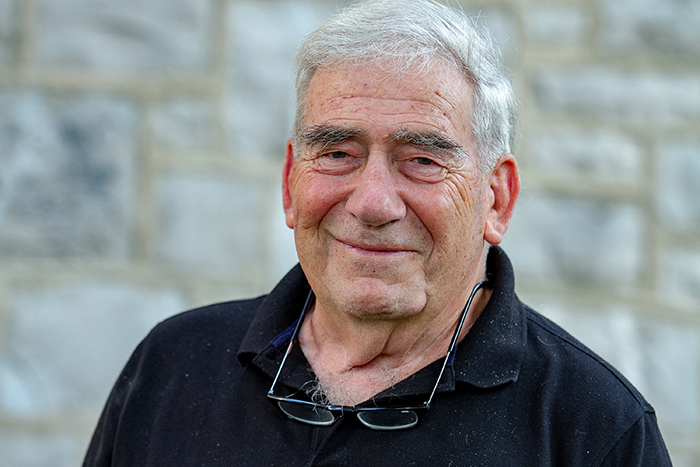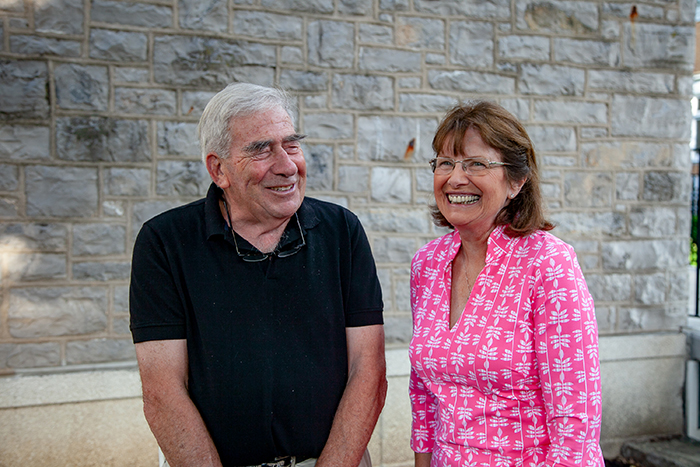Child Survivor of WWII Recalls Wartime Experiences and Road to Fulfillment, Success

Photo by Carl Socolow '77.
Louis Reens '54 shares memorable firsthand moments during and after WWII
by MaryAlice Bitts-Jackson
In the early morning of May 10, 1940, 6-year-old Louis Reens ‘54 awoke to a thunderous roar. Running to the window, he saw a fleet of airplanes filling the sky. “We were Jewish, and my father immediately knew what was happening,” he recalls of the Nazi invasion of his native Holland. “He said we’d better try to escape.”
The family boarded a boat in nearby Amsterdam, but Reens’ father had second thoughts, and they returned home (after the war, they learned that the boat had been torpedoed, and the passengers were rescued). They had to find another way to survive.
So begins Reens extraordinary recollections as a child survivor of World War II. While celebrating his 65th class reunion at Dickinson this summer, Reens shared his story of struggle and perseverance, and of the successful life he built at Dickinson and beyond.
Escalating tensions
Soon after the Germans occupied Holland, Reens and his two brothers were forced to wear a Star of David and ordered to stay home from school. Soon, they were rounded up into a gymnasium, stripped down for inspection and shipped off to the “Jewish ghetto” in Amsterdam.
Reens’ father, an insurance man, turned to a Christian colleague, Herman Scheltema, for help. Scheltema offered to take 7-year-old Reens into his home, and another business associate agreed to house Reens’ parents and two older brothers. So one day Reens followed his dad to the insurance office, where Reens met the man who would hide him from the Nazis for nearly three years.
“He took me outside the office and said, ‘See that tall gentleman there? Follow him, stay with him and I’ll see you as soon as I can,’” Reens remembers. “It was a difficult time.”
While Reens’ parents and brothers remained confined to an attic throughout the war, Reens—the only blond in his family—could pass as a distant Scheltema cousin, so he could venture outside to play. He was not, however, permitted to attend school, and because German soldiers had a visible presence in town, there was always the possibility he’d be found out.
A radio, a generator and a foxhole
The Scheltema siblings—four boys and one girl—ranged from age 16 to the mid-20s. The oldest and youngest, Hans and Maarten, helped with Reens’ schooling.
Hans had studied engineering, and he taught Reens to build a crystal radio. Dialing in broadcasts from England, Reens picked out the few English words he knew and reported war news back to the family, which tracked the movement of the Allied forces by placing pushpins in a map. When the family lost electricity, Hans showed Reens how to create a low-voltage electricity generator from batteries and a cork. It supplied the three volts Reens needed to power a lamp, so he could read at night.
During the Battle at Arnhem, Reens could hear bombs and artillery from the front lines, about 10 miles from the house. Another charged moment arrived in 1944, when he and the Scheltemas walked across some heather fields, along railroad tracks, on their way to visit the Scheltemas’ extended family. As the Allied troops swept through the area, opening fire on Germans who were attempting to destroy the railroad line, they dove into a foxhole for cover.
"We wanted to cheer for the Allies, but it would’ve been too dangerous,” Reens remembers.
Throughout the war, Reens helped out with the family’s garden, but as winter 1944 rolled in, the family’s supplies of apples, potatoes and beets grew perilously low. They ate foraged food—including tulip bulbs, which are poisonous if prepared incorrectly. Relief came in the nick of time, when the Allied pilots dropped air packages, with coveted Hershey bars inside.
Another memorable moment arrived during a momentary break in the fighting in Holland, when Reens’ dad traveled 15 miles to briefly visit his son. For Reens, who was fascinated with machinery, a glimpse of the automatically operated German V1 rocket bombs brought a mixture of trepidation and thrill. He could hear the automatic bombs explode from a few miles away, and he could see supersonic V2 bombs going straight up in the air, before they’d curve toward London.
When Reens heard the end-of-war announced on his crystal radio, he rushed out into the streets with his host family and their neighbors to cheer on the Canadian soldiers passing through. “I remember the tumultuous reception,” Reens says. “Anybody who wanted to climb onto the tank could ride into town.”
Rebuilding a life
Reens’ reunion with his family was bittersweet: After years locked together in an attic, his parents and brothers were gaunt, weak and traumatized, and his mother had suffered a stroke. His younger brother, whom he initially didn’t recognize, needed to relearn how to walk. Roughly 80% of their relatives had not survived.
Their home had become occupied by a Dutch family during the war, so the government granted them a vacant home in the same neighborhood. Reens graduated from grammar school and attended a high-level technical school in Amsterdam, as his middle brother moved to Israel. When a coup broke out in Czechoslovakia in 1948, their father sent Reens and his oldest brother to America, where a family friend sponsored them. Reens’ parents followed, six months later.
Fresh off the boat, leather suitcase in hand, 14-year-old Reens was surprised and impressed when his NYC taxicab driver offered him a cigarette. His first purchase: a pair of long, scratchy pants that replaced his unfashionable Dutch knickers and saw him through his first year in the States.
“I knew maybe 10, 15 words in English. That's about it,” he says with a chuckle. “And so everything was new, everything. I had to learn and be alert.”
After a short stint in the city’s public schools, Reens enrolled at a Connecticut boarding school. He made good friends who taught him tennis and took him to a 52nd-street speakeasy, and a professor’s wife helped him with his English pronunciation. He was now ready for his next adventure.

Last summer, Louis Reens '54 returned to Dickinson for his 65th reunion, along with his partner, Jean. Photo by Carl Socolow '77.
A passion for science and math
Reens earned a scholarship to Dickinson, and at age 16, he walked from the Carlisle train station to campus, his old Dutch suitcase in tow. As an undergrad, he joined Phi Epsilon Pi and studied physics and math (he still recalls, with delight, a physics professor’s demonstration of the Coriolis force). During the school year, he worked in a nearby gas station, and during summers, he waited tables in the Poconos and also read meters for PP&L.
“My Dickinson education was an important part of my life,” he remembers. “I gained the knowledge I needed to go forward, and I learned what life is about.”
Reens graduated at age 19 and enrolled at the Brooklyn Polytechnic Institute to study electrical engineering. As a grad student in New York, he lived in a cold-water flat in Greenwich Village, and he met his future wife, Paula, in Washington Square Park. After graduation, he got a job implementing circuitry design, but he didn’t enjoy it as much as he’d hoped. So he moved his growing family to Connecticut, attending University of Connecticut's law school at night and working at United Aircraft (now United Technology) by day as a part of United's patent licensing team, just when jet engines were emerging onto the market.
“I loved the airplanes, and I spent a lot of time walking the factory floor,” says Reens, noting that the company had a private airfield next to his office. “I remembered the power of the airplane engines when I saw them fly overhead in Holland.”
After earning his law degree, Reens set up practice—first in New York City, and then in Connecticut—with St. Onge Steward Johnson & Reens. He also got involved in local politics in Wilton, Connecticut, and served as second selectman.
In the 1980s, his wife, Paula, had the first of several strokes, and Reens took care of her until her death in 2017. Their oldest son, Brian, now lives in Israel, and the youngest lives in Connecticut. Between them, they’ve given Reens five grandchildren and three great-grandchildren.
Resilience and curiosity
Reens retired from law in 2003, at age 70. Now 85, he plays tennis twice a week and, until recent years, took astronomy classes at Yale. With a Yale postdoc, he used a high-tech telescope on the Mountain Kitt Peak, Arizona. There, they made a discovery, and Reens was surprised to later learn that he was listed as a co-author for “A New Gravitational Lens,” a paper published in the November 2003 issue of Astronomical Journal.
Reens still has the suitcase he brought with him to America, as well as the stamp collection he kept during the war. He and his partner, Jean, recently traveled to Amsterdam and visited Reens’ dad’s insurance office. They spent Alumni Weekend at Dickinson, where Jean’s granddaughter, Hannah Shea, is a member of the class of 2022.
Reens has spoken publicly about his wartime experiences, and he is included in One Out of Ten, a child-survivor documentary produced by another child survivor. He’s a gracious and energized storyteller, but he resists lingering in the past for too long.
“A lot has happened in 65 years,” he says with a smile. “You can’t stand still in life. You make the best and move forward.”
TAKE THE NEXT STEPS
Published September 27, 2019